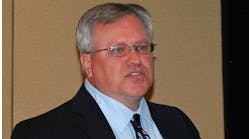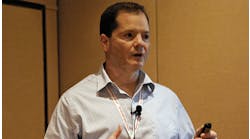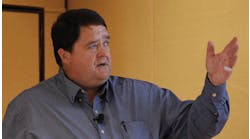“Several of our customers are moving into battery storage because they want to reduce their carbon footprints.” Ujjwal Kumar, president of Honeywell Process Solutions, emphasized the company’s commitment to sustainability at this week’s Honeywell Users Group Americas conference in Orlando, Fla.
“We are on the edge of transition,” began Ujjwal Kumar, president of Honeywell Process Solutions, who welcomed more than 1,200 customer attendees to the company’s 2022 Honeywell Users Group Americas conference, held this week in Orlando, Florida. “Of course, we are also in the midst of transition. When the world was locking down, many companies were seeking transformational change. It feels like the pace of change has been permanently altered.”
While companies’ journeys may be different, the destination looks the same, explained Kumar, citing ongoing progress on efficiency, autonomy and diversity fronts. “The route up is going to vary, but we’ll see the same view from the summit.”
Honeywell’s efficiency and sustainability contributions derive from solutions for process automation and optimization, emissions control and reduction, hydrogen production, and battery technologies.
“We are also enabling autonomous operations safely, reliably and efficiently with limited human input,” said Kumar. “And we enable businesses to hire a greater range of voices and talents.”
Renewables play a role in many companies’ sustainability plans. “But the sun doesn’t shine all day long, and the wind doesn’t always blow,” explained Andrea Bozzano, senior director of R&D at Honeywell UOP, a sister company to Honeywell Process Solutions within Honeywell’s Performance Materials and Technologies division. The inability of lithium extraction to keep pace with demand is just one of the factors behind the ongoing development of redox flow energy-storage batteries, which is part of Honeywell’s continuing transition toward more sustainable manufacturing solutions, Bozzano said.
“Lithium-ion batteries have a sweet spot in the two-to-four-hour storage duration. The redox flow battery has several advantages. It has a much more flexible range, from one to 12 hours. And redox flow batteries are inherently safe, while lithium-ion batteries are prone to degradation.” Redox flow batteries experience minimal degradation over the course of 20 years.
Redox battery storage offers scalability
Lithium-ion has high energy density and charge/discharge time, explained Bryan Glover, president, Honeywell UOP, in a follow-up media briefing. “The great part of redox flow is the rate of power delivery. The electrolyte is infinitely scalable,” he said, noting 500 MW can be delivered for as long as necessary by scaling the electrolyte tank size.
“That can provide an hour’s worth of energy or longer,” Glover explained. “It’s a really good option for longer-duration applications; the tank for the electrolyte is the only change. It employs electrolyte solutions that don’t have flammability or other issues. Our flow cell is the right combination of electrolyte and structure. We’re looking at small-scale prototypes right now.”
Honeywell has an agreement in place with Duke Energy to supply a 100-kWh demonstration unit for testing this year.
And because the catalyst is printed on a membrane, the redox flow battery is a materials play, and fits in with UOP’s strengths. “We are a membrane company,” emphasized Glover. “In a flow battery, the electrolytes don’t live in the cell. The electrolyte passes its proton charge across the membrane.”
Adding to its sustainable attractiveness, the redox flow battery’s case is made of recyclable plastic. “And flow batteries are, as a system, readily recyclable because you don’t have little cells that have to be split apart,” explained Glover. “Because of the energy density profile—most of the electrolyte cell is water—it’s best for stationary applications, but we see it broadly applicable as grid-level storage because of the long-term characteristics of the discharge cycle, potentially paired with wind or solar. Another good application is backup power. The cost curve is relatively flat. The best application would be large-scale stationary power, primarily grid-connected, that requires more than four to six hours.”
While the focus of energy storage is on electrochemical batteries, Glover insisted the energy-management system can be anything and doesn’t have to be electrochemical. “It could be a combination of facility-level or grid-level storage,” he offered. “It’s about the management of the charge and the discharge.”
Sustainability is one of Honeywell’s key transformational imperatives, emphasized Kumar. “We have several solutions around driving more accountability,” he said. “Sustainability is more than just reducing carbon footprint. We are looking at other technologies, and we will keep bringing other storage solutions. Several of our customers are moving into battery storage because they want to reduce their carbon footprints. For them it’s also critical to know if the battery was manufactured in a sustainable way.”
The editors of Control, Control Design and Smart Industry are reporting live from 2022 Honeywell Users Group in Orlando, Florida, to bring you the latest news and insights from the event. When the event comes to a close, the best, most important coverage will be compiled into a report by the editors.
Register now to pre-order the report and be among the first to receive it in your inbox.





